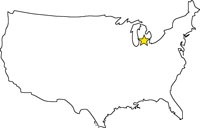Imagine a World Without Road Signs
2nd Jun 2017
Informational signage is, arguably, among the most useful and relied upon innovations of the modern world. Where would we be without it? Probably lost on a back-country lane somewhere or stuck in an interminable traffic jam, having no idea what direction to go in even if we could move. Arriving at anonymous streets and unidentifiable places of business; looking for destinations with only our memory and a little word of mouth to guide us – not knowing when or where a chicken may be crossing a road.
Informational Signs Have Been Around Since Ancient Times
Though many notable ‘firsts’ have been recorded, the exact origins of signage are difficult to pinpoint. Humans have, from cave walls on, seemingly always understood the relevance of sharing information and the importance of road signs. Signage is evidence of man’s desire to relay what he knows to be useful.
Romans used stone posts to indicate distance (to Rome, of course . . . all roads lead there). Wood was then used for quite a long time, until about the 1800s. Since then, signage has gone from iron to steel to aluminum to plastics in a relatively short time. Lighted sign technology has evolved as well, from oil lanterns to neon gas to fluorescent tubing to LED. Each manifestation of sign technology helps to make it more readable, more flexible, more reflective and less prone to weather damage.
Through the post-industrial decades, signage has also become more standardized. This is one of the reasons that many of us can remember, as kids, ‘reading’ signs along the road from the back seats of cars. At first, we really weren’t reading at all. We were recognizing. We often said ‘stop’ and pointed when we saw a big red octagon. We probably questioned why mom or dad was passing the ‘do not pass’ sign. We knew that red meant stop, yellow meant caution and green meant go. And it provided many of us pre-digital kids with hours of entertainment on those long road trips.
Standardization of Road Signs
How were we able to do all of this before we could really read? We could identify signs because of standardization – of background colors, font colors and styles, sign shapes and sizes (eventually, we began to understand the letter sounds). In advertising, this kind of standardization is known as branding – basically, it provides for easy, instant recognition with an inherent, understood message or meaning.
Blue for rest and restaurant stops, brown for parks, green for exits and street names, white and black for speed limits, and so on. MUTCD (Manual on Uniform Traffic Control Devices) provides details on standards and regulations for road and traffic signs.
The 1920s saw the first movements toward regulating traffic signage. Several groups around the country were aware of the importance of road signs and were making inroads in this area. In 1932, two of these groups united and eventually published (in 1935) the first edition of MUTCD.
MUTCD – A History of America’s Roads
Since 1935, in addition to rules, MUTCD’s publications have also provided a living history of the way America uses its roads. Traffic signage, and its regulations thereof, are a story of changing times, frontiers, population expansions, the growth of suburbia, traffic management and the technology of motor vehicles.
It goes without saying that informational signs are imperative for a society’s ability to function. Signs tell us what to do, what not to do, what to be alert for, where to go and how to get there. Today’s digital signage can also estimate drive times to specific locations, tell us what speed we’re going and warn us of major road obstacles and construction ahead – they’ll even suggest detours. Those who work on road construction teams rely on such signage and our adherence to it for the preservation of their lives. In a sense, we all rely on signage for increased knowledge and safety, on roads and off.
Today, there are even signs designed with technologies that make them accessible to people with various disabilities. Smart crosswalks are a great example of such technology in use. Around the world, countries have their own sign standards and regulations in place. Most types of road signs, though, particularly ones with graphical images on them, can be interpreted by most people.
Dornbos Sign – Your Go-To Experts for MUTCD-Compliant Signage – And Much More!
At Dornbos, we have a wide variety of safety and informational signs, and a team of experts to help guide you. We even have a little bit of fun. To create a custom sign, click here. And, don’t hesitate to call us at 800-922-0029 if we can be of any assistance. We look forward to serving you.




